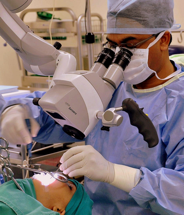
Unlike traditional tonsillectomy procedures, which remove tonsils by cutting and/or burning, Coblation is advanced technology that combines gentle radiofrequency energy with natural saline – to quickly, and safely remove tonsils. Because traditional procedures use high levels of heat to remove the tonsils or to stop the bleeding that occurs when the tonsils are cut out, damage to surrounding healthy tissue is common. Coblation does not remove the tonsils by heating or burning, leaving the healthy tissue surrounding the tonsils intact.
The innovative approach of Coblation results in a fast and easy recovery for patients.
Coblation has been used in nearly two million procedures by surgeons in ear, nose, and throat (ENT) and other areas of medical specialty.
Patients report a better overall experience with Coblation-Assisted Tonsillectomy after surgery when compared to traditional tonsillectomy procedures. Studies show that patient calls and visits to the doctor due to complications after surgery are significantly less with Coblation-Assisted Tonsillectomy.
Because of tissue damage caused by the heat of traditional tonsillectomy procedures, patients often take up to two weeks to return to a normal diet and to resume normal activity. Coblation-Assisted Tonsillectomy is the gentle alternative offering a rapid recovery and minimal discomfort, with most patients resuming a normal diet and activities within just a few days.
Coblation-Assisted Tonsillectomy is a quick daycare procedure that takes less than 30 minutes, and is performed in an operating room in either a hospital or an ambulatory surgery center with general anesthesia. Most patients stay in the facility only a few hours after the procedure is completed although some doctors choose to observe the patients overnight.


1.Coblation Tonsillectomy with Microscope & 2.Diseased Tonsils removed during surgery
Your doctor or nurse will provide post-operative instructions, which may include antibiotics and oral rinses for up to 1 week. Some minor pain medication may also be
prescribed.Patients should discuss the possible risks and complications associated with any procedure performed under general anesthesia (including tonsillectomy) with their doctor.
For all tonsillectomy procedures, in addition to general anesthesia risks, 2-3% of tonsillectomy patients can experience post-operative bleeding (up to 5-10 days after surgery). Fever can be present, and dehydration and weight loss can occur, especially among children who won’t eat or drink due to pain.
(This article is adapted from www.arthrocareent.com)
Copyright @ 2023 | All Rights Reserved by : DAS ENT Care